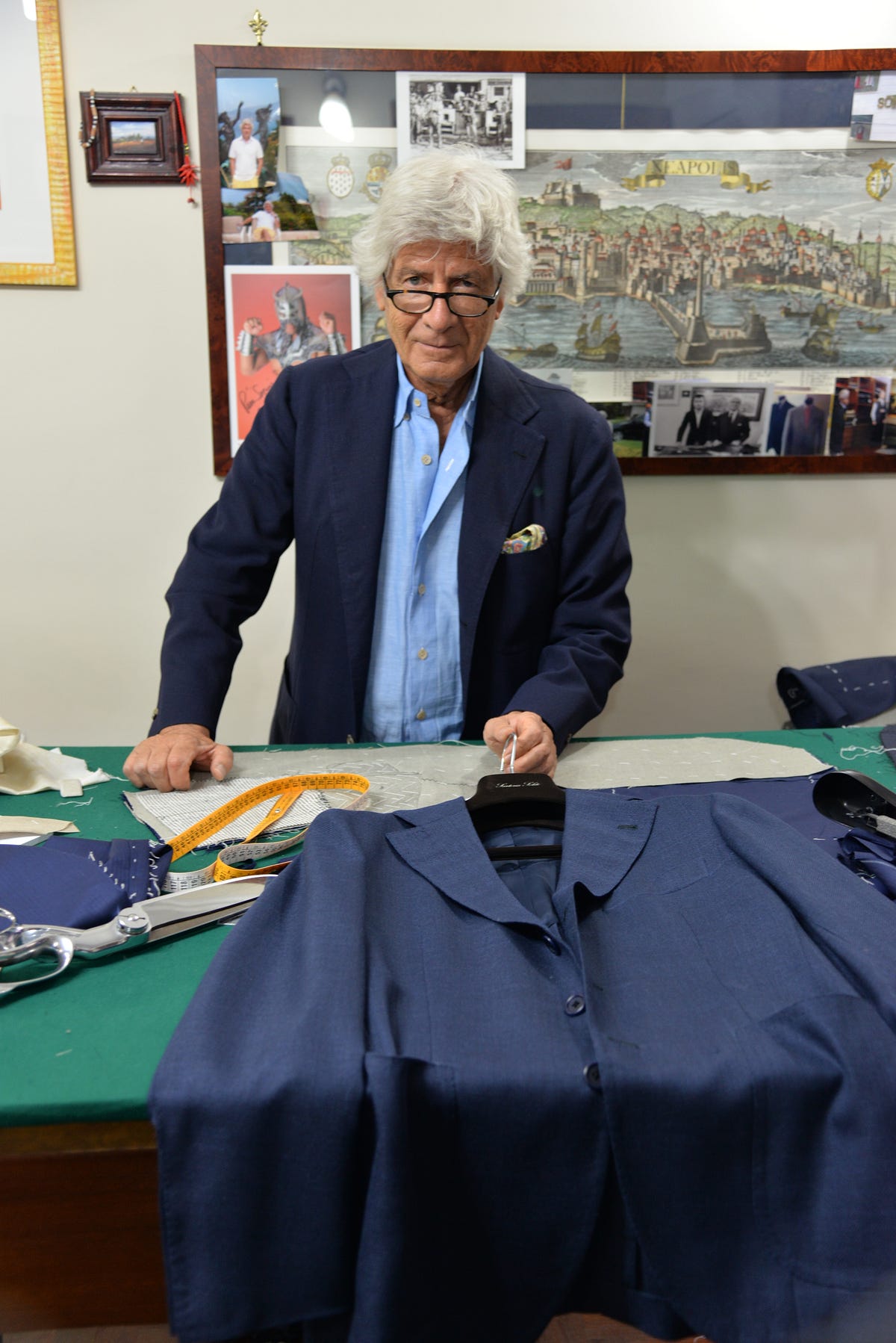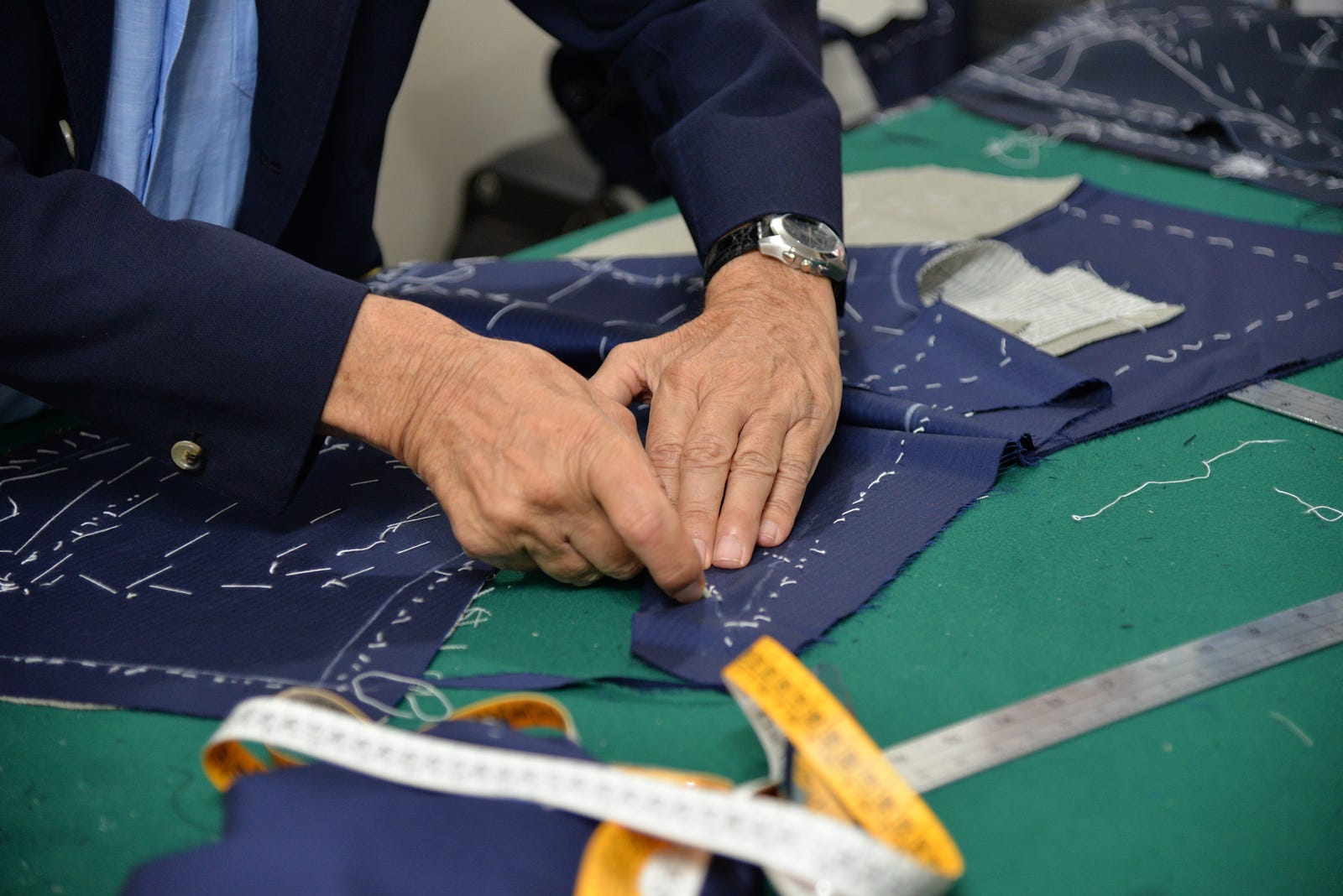
There’s quite a view from the terrazza of the Scotto house in Monte di Procida, Italy. You have the islands of Ischia and Procida to your right, the gulf of Naples straight ahead, and Mount Vesuvius to your left. Just over the hills to the left of that view of the Gulf is a tradition, or more so an art form, that has an uncertain future.
While on our tour of southern Italy visiting family and friends last month, I had the honor to sit with Luigi Solito of the storied Neopolitan tailoring house Sartoria Solito. Luigi is a third generation real deal Neopolitan Tailor. Luigi’s Grandfather started the tailoring house in 1946. His Father, Gennaro, began learning the craft at the age of nine. That’s right, nine years old. After WWII the need for security and to rebuild surpassed everything else, so Gennaro picked up a scissor instead of a soccer ball and cut ahead.
Luigi began his career at 18, spending close to a decade perfecting the craft of creating a traditional Neopolitan jacket. When we meet he apologizes for his casual attire yet he is still dressed like he is ready to shoot a ad spot. A perfectly tailored, long sleeve, bespoke spread collar polo with immaculately fitting olive trousers. Bespoke polo shirts are a new offering from Sartoria Solito and definitely a nice touch. After the history lesson on Sartoria Solito, he explains how up until the late 90’s a Neopolitan tailor only served the neighboring cities and the occasional businessman from Milan. As the online world grew and the offline world became smaller, that same Tailor was now able to bring his craft to countries beyond the boot.

This allowed Luigi to focus on building the business and expanding the clientele of Sartoria Solito. They always remained a true tailoring house, at most creating 30–35 suits a month. Each suit jacket is made by hand by a single tailor, most likely Luigi or his father, Gennaro , and takes approximately 28 hours to complete. As Luigi explains this to me Gennaro takes a break from cutting a jacket to ask when is tomorrow’s first appointment. This is what true Bespoke means, and people who understand this will wait up to 6 months for a Sartoria Solito suit. Larger tailoring houses like Kiton, Isaia, and Zegna have this process broken down into an assembly line so they can produce hundreds of times that. This catena di assemblagio (chain of assembly) is one of the reasons why the traditional tailor is an endangered art form. I look up and see Gennaro nodding in agreement as he continues to trace a chalk outline around a beautiful pinstripe fabric he is preparing to cut. He wears glasses, most likely from a lifetime of intensely focusing on the fine detail of needle and thread, but his hands move as if he could do this blind. His silver hair is that medium length classic Italian style. He embodies that effortless ‘sprezzatura’ style that the Neopolitans are so famous for.
Countless menswear brands have popped up in recent years boasting their “bespoke tailoring,” quick turnaround times, and affordable prices. Bespoke does not mean typing in some measurements on a website and having an underpaid tailor rush through making your garment because you need to wear your suit in two weeks. Younger consumers see these brands and are misled to believe that they are actually getting a bespoke suit. They don’t know the difference between a canvas construction and a fused construction, and they will never meet the individuals who are putting together what should be one of the most important pieces in their wardrobe. I only hope that there are younger consumers who will mature and begin to understand what true mens tailoring is and then upgrade to buying 1 or 2 suits a year from a true tailor like Sartoria Solito.

The other factor affecting the future of the traditional tailor is the labor supply. The youth of Italy don’t have the same patience or commitment as the generations before them. The minimum training that a tailor must endure lasts 4 to 5 years. Training that requires great sacrifice, long hours, and little pay. There is potential for great returns on that investment, but almost all of the young tailors Luigi meets prefer to go work at one of the big brands. It’s a much easier life with set hours, 5 day workweeks, vacations, and a steady paycheck. Most of the time they don’t become true Tailors, meet with clients to take measurements and complete the jacket from start to finish. They find their place on the assembly line and become an expert at sewing a lining, attaching a sleeve, or opening a button hole. Maximum efficiency for maximum output.
As I reflect on this conversation two thoughts come to mind. The first is that, yes, this lifestyle involves a big sacrifice, but it is no different than becoming a Chef. Yet there are so many people begging to work in the best kitchens of Italy for even less pay and longer hours. The modern Chef is glamorized and put on a pedestal with all of the reality shows and movies that glorify the sacrifice and eccentric lifestyle they have. I’m not saying that it isn’t deserved, but unfortunately the Tailor does not have this help.
The internet and social media have started to change this, by giving us a glimpse behind the scenes, but it can hurt their business as well. If a Neapolitan tailor had to stop and take a selfie for snapchat, then an artsy pic of his hands for instagram, and then write a facebook post it would take him a month to make a jacket.
The other thing I couldn’t stop thinking about when Gennaro would come in and out of our conversation to speak with his son about the business, is that this could have been me. If my Dad stayed in Italy and continued to work as a tailor he probably would have handed the craft down to me and I would be in the same position as Luigi, trying to balance tradition and innovation, art and business. My parents had been in this country for 15 years by the time I was born. When I was 5 we moved from Queens to an all white suburb on Long Island. The seeds of the American dream to go to college, work in finance, and get rich were firmly planted in their minds as the best path for their only son. Well I started down that path, but you can’t change whats in your heart. I knew I didn’t belong in that world and little by little I found my way to where I am today. I still can’t make a garment pattern, but I have had the opportunity to watch my dad do it many times. I am learning the building blocks of this craft as I forced my way into the family business with an idea, made in NYC. That’s all it took. It sounded great at the time and seemed like it could take off. Four long years later we are still grinding it out trying to make our place in this incredibly difficult industry. Although we haven’t had a lot of success yet, I wouldn’t trade this path in for anything. Regardless of the peaks and valleys I know I am doing something special and trying my best to carry forward something that is not easy to find in this world. I hope that Luigi can do the same and continue the beautiful craft of Neopolitan Tailoring.
A lesson on Tailoring- Napoli Style
If you’re not familiar with Neopolitain tailoring here is a quick lesson. The true Napoli style jacket is more a work of art than a garment and has several distinct features that set it apart:
- Rolled or Shirt shoulder with little or no padding
- 3 su 2 (3 over 2): The jacket appears to be a 2 button, but actually has a 3rd button at the top which is hidden under the roll of the lapel.
- Boat pocket (a barchetta): The chest pocket is cut by hand with a slight curvature that makes it look like a small boat.
- Patch pockets: Also cut by hand with a curvature that only a true Neopolitan tailor replicate, these pockets sit on top of the jacket instead of inside.
- La Sprezzatura: This you cant translate. It’s the Neapolitan attitude toward style that says “I care, but I don’t care”. If you really want to have that southern Italian style you have to be put together and polished, but in an effortless way that exudes confidence. That’s the feeling you get when you put on a real sartorial jacket from Naples. If you are trying too hard, you’re doing something wrong.
- It is entirely cut and sewn by one single tailor and takes approximately 28 hours to produce (for an expert tailor).

